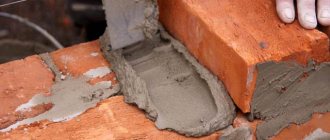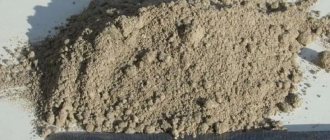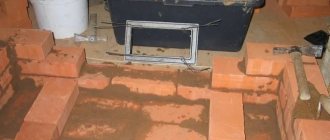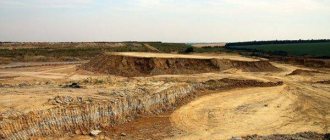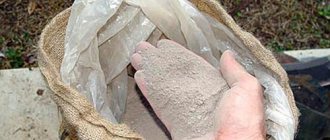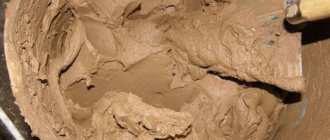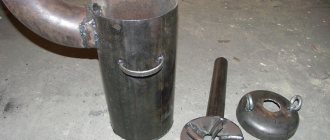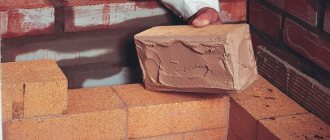Perhaps no cozy private home can be imagined without a good stove or fireplace. In addition, to this day, many people living in areas without gas supply are simply forced to heat with wood.
Brick mortar for oven proportions
On the one hand, this is the most environmentally friendly heating method, and on the other hand, it is economically profitable. Prices for alternative fuels and electricity maintain a steady upward trend, so it is necessary to look for the optimal way out of the current situation.
Many people want to learn how to install stoves, and this is not only due to the desire to save money on heating in winter. The practical skills acquired during the training process can be an excellent help in developing your personal business. The demand for furnace work is growing every year, creating prospects for fairly high earnings.
No. 1. Furnace elements and type of solution
A stove is a responsible structure, the strength and durability of which depends not only on the brick chosen for it, but also on the mortar with which these same bricks are held together. At the same time, a number of negative factors affect the stove, and since there is no single masonry mortar that can cope with frost, high temperatures, and icing, it is necessary to use different compositions :
- for a foundation that bears the main load but will not experience any special thermal effects, you can use cement-lime or lime mortar;
- for the heat-storing part a clay solution is best suited ;
- for the combustion part , where the temperatures are maximum and the chemical effect is not strong, you can take a clay or clay-fireclay solution ;
- For the source of the chimney , which is exposed to temperatures up to 4000C, a clay solution , and a lime solution is suitable for fluffing ;
- for a chimney where the temperature is low, but there are wind loads, lime mortar , some even allow ordinary cement.
1 - foundation, 2 - firebox, 3 - smoke circulation, - cladding, 5 - chimney
No. 2. Mortars for laying a furnace: types and characteristics
For laying a brick stove, the following solutions can be used (the first three are more common, the others less common):
- clay - the cheapest (all components can be found for free), but at the same time, its preparation is the most labor-intensive. Its strength is average, but its heat resistance is record-breaking - up to 11000С, which allows it to be used in furnaces. The solution has high gas density, i.e. ability to trap flue gases. Although preparing the solution is difficult, it is quite easy to work with it, because it is suitable for an unlimited time. If it is dry, just moisten it a little to restore its properties;
- mortar It will cost more than clay, but is easier to prepare. The strength is higher than that of clay, it can withstand temperatures up to 5000C, has an average gas density, “does not breathe”, can be used for outdoor work;
- cement-lime is superior to lime in strength, but inferior in heat resistance and can withstand only 2500C , the gas density is low;
- clay-fireclay repeats the properties of clay, but has a higher heat resistance, which is 13000С. It is more expensive than clay sand, since fireclay sand will have to be purchased, and it is not cheap;
- Cement-fireclay is similar in properties to clay, but is expensive, and you need to work with it quickly - 40-50 minutes after mixing it becomes unusable. This mortar has high gas and heat resistance, and the strength is almost like that of cement-lime.
When arranging stoves, gypsum-lime mortar is also used, but it is used exclusively for facing work.
How to calculate volume
To plan your bricklaying budget in advance, it is advisable to calculate how much and what will be required. The main guidelines in this case are the volume of the walls being constructed and the type of mortar used, which affects the proportions of the ingredients.
Calculation of the volume of brickwork
Let's say you need to build a simple building where the walls are 700 cm long, with a ceiling height of 300 cm. The wall has one opening for doors 210x130 cm, and a pair of windows 180x120 cm. For the thickness of the walls, you can take 2.5 bricks (64 cm). To calculate the volume of masonry, the number of walls is multiplied by their height and thickness. After rounding the result is 54 m3. The volume of door and window openings (4.5 m3) is subtracted from the result obtained. The result is 49.5 m3 directly on the walls; free areas are not taken into account here.
Mixture calculation
To determine how much ready-mixed mixture is needed, you need to know how much mortar per 1 m3 of masonry. The solution consumption per cube of masonry is usually in the range of 20-30%. For calculation, we select the average indicator of 0.25, which is multiplied by the number of the total volume (49.5). As a result, we get 12.4 m3 of solution. It is also necessary to calculate how much cement is required, since it is the most expensive component. As you know, each brand of mortar has its own ratio between sand and cement. If a 1:4 proportion of sand and cement is used, then it is necessary to purchase cement in an amount of 2.5 m3. Based on the average density of this material (1300 kg/m3), it is easy to calculate its weight (3250 kg).
At the last stage, the exact number of bags is calculated. Typically, cement is packaged in 50 kg packs, so 65 bags will be required. They try to purchase construction materials with some reserve, so it is better to take 66-67 bags.
No. 3. Clay mortar for oven
The set of components for a clay solution is outrageously simple: clay, sand and water . The difficulty lies in selecting suitable raw materials and the optimal ratio of components , which depends on their quality, so many decide not to bother and buy a ready-made mixture (more on this below). Stove makers make a masonry seam 3-4 mm thick, but if you make the seams thicker, the clay may begin to crack, air is sucked into the cracks, which reduces draft and increases fuel consumption, and also increases the risk of carbon monoxide escaping into the room. On average, about 3 buckets of clay mortar are needed for 100 bricks. The most interesting thing about this composition is the ability to dismantle the masonry without damaging the building material.
The main parameter of the clay solution is fat content:
- fatty solutions have high plasticity, but when dry they can crack;
- thin solutions are not plastic and crumble when dry;
- normal solutions shrink slightly, have sufficient plasticity, and after drying almost do not form cracks.
exact proportions of clay, sand and water for preparing a high-quality solution - it all depends on the characteristics of the components. Sand is usually added to clay from 0.5 to 5 parts, the most common ratio is 1:1 and 1:2. Water is added to about 1/4 of the volume of clay. There have been ways to make clay mortar more durable by adding table salt (150 g per 10 kg of clay) or cement (1 kg per 10 kg of clay), but if you choose the right raw materials for the mortar and mix it in the required proportions, then such additives will not be needed.
Checking the quality of clay
Experienced professionals can determine the quality of clay by touch, while everyone else will have to work hard and do several experiments. You can prepare a clay solution for the stove with minimal financial investment - you only need labor and time.
Clay is a common mineral and it will take a little time to find it on or near the site. Only medium-fat clay ; the fat content is determined by the ratio of aluminum and silicon oxides: the more of the former, the fatter it is. It’s easy to check fat content:
- first way involves taking a little clay and, after wetting it, molding a ball with a diameter of 4-5 cm. It is placed between two boards and squeezed, observing when cracks begin to appear. If the clay is thin, then the ball will fall into pieces even with slight pressure, or cracks will appear when it is compressed by 1/5. If the clay is oily, the ball will crack when compressed by 1/2. We need normal clay, the cracks in which appear when compressed by 1/3;
a - lean clay, b - normal, c - oily
- the second method involves the formation of flagella 15-20 cm long and 4-5 cm thick, stretching them and bending them around a rolling pin or the handle of a shovel. Fat clay stretches smoothly, and the ends at the break point will be sharp; when you bend it around a rolling pin, there will be no cracks at all. Skinny clay breaks off abruptly, gives an uneven break, and when bent, numerous cracks. Normal clay stretches smoothly, breaks when the joint becomes too thin (1/5 of the diameter of the rope), and when bent it forms small cracks;
a - fatty clay, b - normal, c - lean - third way It is supposed to form a ball of hard dough with a diameter of 4-5 cm and a flat cake with a diameter of 10 cm. When the samples dry out after 2-3 days, they are inspected for cracks. Oily clay will be covered with cracks, and if dropped from a height of 1 m, the ball will not break. Skinny clay will not crack, but the ball will break when it hits the floor. Normal clay does not crack or crumble;
- The fourth method will require pouring 2-3 kg of clay with a large amount of water. After the lumps are broken, the suspension is mixed with a paddle. Normal clay leaves separate clumps on it, skinny clay covers it with a thin layer, and fatty clay sticks strongly and completely envelops the funnel.
adjust the fat content of the clay by adding sand (for oily clay) or richer clays (for skinny clay). How much water and sand to add to the clay solution depends on the characteristics of the clay available. This will be discussed further.
Sand selection
White quartz sand can be used in furnace work; yellowish spar sand is also suitable, but not for laying bricks in the firebox area. Self-dug sand must first be sifted through a sieve with 1.5 * 1.5 mm cells, which removes debris, particles of roots, grass, gravel, etc. It is more difficult to get rid of fine organic matter, which is necessarily present in the sand, and over time can deteriorate the quality of the masonry. It is removed by flushing - this method is cost-effective if there is an independent source of water supply. Otherwise, it will be cheaper to buy suitable sand, which has already been freed from organic matter by drying or heating.
For washing, you can use a piece of pipe with a diameter of 15-20 cm and a height of 3 diameters as a container. Fill it 1/3 with sand and turn on the water. The procedure is completed when the water comes out clear within 5-10 minutes.
If you decide to buy sand , then it is advisable to take several fractions of it and mix it - this will make the masonry stronger. You can mix sand of fractions 0.7-0.9 mm (1 part) and 0.15-0.25 mm (2 parts).
Water preparation
Water for the solution should be soft and slightly mineralized . Once upon a time, stove makers specifically collected rainwater for these purposes, but today you can use artesian water. Wells located on the site must have documents indicating the approximate water hardness. If the magnesium and calcium salts in the water are more than 250 mg/l, then it is not recommended to use water to prepare the solution, and softening it will require considerable costs.
How much sand and water to use?
Another difficult point is determining the required proportions for the future solution. The ratio is determined experimentally:
- The clay sample is divided into 5 equal parts, water is added to each, with a volume of approximately 1/4 of the volume of clay. A day later, when the clay has become limp, it is kneaded, passed through a sieve with a 3 mm mesh and again left for a day. If cloudy water is then squeezed out, it must be drained;
- The first sample is left without sand, 1/5 of the clay is added to the second, 1/4 to the second, 1/2 to the third, 3/4 to the fourth, 1 part to the fifth. Sand is added in several stages, thoroughly mixing the solution samples;
- from each solution, two strands 30-40 cm long and 1.5 cm thick are made, a ball with a diameter of 4-5 cm and a cake with a diameter of 15-17 cm and thick as a finger, the samples are marked so as not to get confused, and left to dry for 2-3 days;
- repeat the experiment, as with testing clay for fat content: stretch one rope and look at the nature of the break, the second one is wrapped around a rolling pin or the handle of a shovel. A normal solution should break by 1/5 of the original diameter, and when wrapped, small cracks appear on the crust and slightly below it. A greasy solution will not crack, but a thin solution will break into pieces and tear with a large gap. This experiment gives ambiguous results, and Several compounds can meet the requirements at once, so we reject those that are definitely not suitable and begin throwing balls and cakes from a height of 1 m. Those that crack are immediately removed from the “competition.” If the test has passed two solutions, increase the height of the fall. We take the proportion of sand the same as in the strongest sample.
All that remains is to figure out how much water to use and specify the proportion of sand. To do this, make a test batch of clay, a selected amount of sand and clean water, add water by eye, about a quarter of the volume of clay, and then look at the fluidity of the solution. We make a hollow with a trowel: if it breaks, then water must be added; if it floats, let the solution stand and squeeze out the water with sludge, preferably into a measuring cup, in order to subtract its amount from that added to the solution and derive the exact formula. Ideally, the trowel should leave a mark with clear edges and not crumble or blur.
The same trowel will help you determine the proportion of sand It needs to be dipped in the solution, and if it turns out to be too greasy, then a continuous layer of clay will remain on the trowel - you need to add sand. Lean solutions were excluded at the previous stage. The ideal composition would be one that leaves a thin layer with curly streaks on the trowel.
Finally, to make sure that the solution can definitely be used for laying the stove , we test its strength . We take a brick, apply a 3 mm thick mortar on it, place a second brick on top, press it, wait 10 minutes and lift it by the top brick. If you managed to lift two bricks fastened together, then the materials and their proportions were chosen appropriately.
Preparing clay mortar for the oven
The classic and easiest way to prepare a clay solution begins with fermenting the clay with the required amount of water. After it has softened (about 1 day), press the mixture through a sieve and add the required amount of sand. It is better to prepare the solution in a large container, for example, a barrel or a tub, stir it with a large planed board (cheerfully), deliver the raw materials in buckets, and carry the finished solution to the masonry on a shield made of boards (strikers). The finished solution should slide off the trowel or shovel, not stick to it, but leave a small mark on the surface .
Places of its extraction
Sand is extracted from a river, from a ravine or from a quarry. There is also artificial (quartz) sand. All these types of sand differ in their characteristics. The sand extracted from the river has few foreign impurities and a fairly uniform structure. This is due to the fact that water naturally polishes every grain of sand, and they acquire an almost ideal smooth, rounded surface and attractive appearance. However, if the surface of river sand particles is too smooth, it negatively affects the ability of the particles to bind to other components of the solution, and this affects its homogeneity. There is no need to wash and sift river sand. The cost of river sand is quite high, since it is extracted in a rather expensive way from the bottom of rivers. This sand is used mainly for decorative masonry, for cladding, for the preparation of plaster mixtures, cement screeds, in the production of concrete, asphalt concrete and bricks, as drainage, as a component of grouts and paints. It is usually not used for pouring foundations and ordinary masonry. River sand can be fine-, medium- and coarse-grained. Medium-grained river sand does not shrink, which makes it ideal for masonry and plastering work. Sand can also be mined from the seabed and has similar characteristics and uses to river sand.
Sand extracted from a quarry needs washing and sifting, because... it has impurities (stone chips, clay, etc.) and is heterogeneous in the size of sand grains. The edges of the sand grains are sharp, which has a positive effect on the plasticity of the solution due to its good ability to adhere to other components of the mixture. The advantages of quarry sand: it is cheaper than river sand, and the adhesion quality of its particles is higher. Clay makes up a small portion of the impurities, and organic particles are absent. Unrefined quarry sand is used for foundations, rough masonry and load-bearing wall masonry. Alluvial quarry sand can be used for the manufacture of bricks, plaster mortars, cement screeds, in finishing works, concrete production, and for pouring foundations.
Gully sand is also very common and is mined by open pit mining. The depth of its occurrence is very small - from several tens of centimeters to several tens of meters. Sand grains have a rough and angular surface, which has a positive effect on adhesion. There are also impurities, so it needs to be cleaned. Of the impurities in gully sand, most of them are clay and organic compounds. This gives the ravine sand mortar good plasticity, which is why it is this sand that is most often used for brickwork. Its cost is lower than that of the river one.
Artificial, or quartz, sand is sand that is not a creation of nature, but is obtained as a result of mechanical grinding of rocks containing quartz. This sand has a homogeneous structure and does not contain impurities. Thus, when deciding which sand to use for bricklaying, you first need to decide what type of masonry will be produced, and then decide which type of sand will be easier and cheaper to purchase and deliver.
No. 4. Clay-fireclay mortar
It is recommended to use clay-chamotte mortar for laying the firebox allow the use of ordinary clay mortar when building stoves with a not very intense thermal regime: these are Dutch and Russian stoves, hobs, and barbecues.
In other cases, you will need gray, white or yellowish clay with high fat content. It is thinned with fireclay sand, but more often, to save money, a mixture of quartz and fireclay sand is used in a 1:1 ratio. Soft water must be used, with a hardness of up to 160 mg/l. The preparation is no different from ordinary clay mortar with one caveat - strength tests are not needed, because it is provided by the original raw materials.
Categories of sand as a building material
This building material is usually divided into the following categories:
Scheme of deep-sea sand mining.
- Ravine. This material is mined in an open pit without forming a quarry. Typically, the sizes of elementary particles range from 0.15 to 3 mm. Their surface is rough and their shape is angular. Advantage: the solution using this sand becomes very strong. Disadvantage: contains many impurities.
- River. It is considered the most profitable because it is mined from the bottom of the river and does not require purification. Sand grains can be of different sizes. Typically, such sand is used for laying facing bricks, but can also be used as a filler for concrete production. In addition, it is customary to include it in asphalt concrete mixtures when laying roads, as well as when forming drainage and as a filler for dyes and grouts.
- Career. This is sand that lies under the ground, but at a small depth from the surface, so its extraction requires the formation of a quarry as a way to develop a mineral deposit.
In addition, there is a classification based on the size of sand grains. There are:
- small - up to 0.2 cm;
- medium - from 0.2 to 0.28 cm;
- large - from 0.29 cm and more.
No. 5. Lime mortar for oven
Clay mortar does not have sufficient strength for laying a foundation, and under the influence of condensation in the chimney pipe area it can generally crack, so lime mortar is used for these parts of the furnace. To prepare it you will need:
- lime dough;
- sand;
- water.
Slaked lime is not suitable for this work - you need to take quicklime and slak it yourself to obtain a known test. It is not recommended to perform this process at home: it is difficult and dangerous. It is better to buy lime paste ready-made at a hardware store.
Preparing lime mortar is tens of times easier than clay mortar . The required amount of self-dug sand is sifted through a sieve with a mesh of 1 mm; fractions of 0.7-0.9 mm are chosen from the purchased one. The presence of organic matter in the sand in this case will not be a problem, especially since lime has biocidal properties. You can take regular tap water: the requirements for its hardness are not strict.
The ratio of dough to sand is 1:3, water is added to the consistency of rich sour cream. This ratio may need to be adjusted. The lime dough is kneaded well and sand begins to be added to it, starting with 1/2 part. After kneading, look at the solution sticking to the solution: ideally, it should stick in a layer of 2-3 cm, and it is until such an effect is achieved that sand is added. Usually this is about 3 parts, but can be up to 5.
The last stage is the fluidity test . We apply a 3 mm mortar to the brick, place a second brick on top, tap and observe the behavior of the mortar. Ideally, there should be a little solution around the edges that will not drain. If it does not squeeze out, you need to add a little water; if it drains, add lime paste, since the amount of sand required to ensure proper plasticity was determined at the previous stage.
How to choose correctly
The masonry mortar plays a major role in giving it the necessary properties and influences the convenience of the work performed, so this creates the need to carefully combine all the components included in the composition so as not to get a negative result.
So, why is sand needed in the solution?
Before you know which sand is best, you need to determine what role it plays in the production of the solution.
It is the main filler, which is extremely important for the composition
Its functions are as follows:
- correct minor surface irregularities in bricks;
- form the volume of solution;
- smooth out shrinkage;
- give a certain color.
First, you need the sand to be as clean as possible, since the quality of the solution is affected by clay - it does not allow water to pass through, which can lead to the appearance of lumps. However, other types of pollution are just as harmful.
If there are at least some foreign particles present in the sand, the solution may lose its homogeneity. At the same time, its ductility will decrease, which will complicate the alignment of rows when laying bricks. For this reason, it is best to sift the sand.
For laying, medium sand is suitable, but for rough work it is permissible to use a coarser version. And in the case of decorative wall decoration, it is optimal to use the finest sand.
No. 6. Cement-lime mortar
Cement-lime mortar is even stronger than lime mortar, and you will need absolutely no cement, and the higher its grade, the less it will be used. You will need a ratio of cement, dough and sand of 1:2:10. First, water is added to the lime dough, mixed and cement is added, without stopping stirring, then sand is added and the solution is mixed. It is better to determine the exact quantities of sand and water in a small test batch.
Helpful information
Masonry methods
Bricks are laid according to special rules so that the building structure is monolithic and durable.
All dosages when preparing masonry mixture must be observed exactly.
Water consumption:
- Concrete grade 100, take 1 part cement from 1/2 to 7/10 parts water;
- Cement-sand mortar. Use 8/10 parts water for one part of cement.
Cement consumption:
- Brand M100 – 300-250 kg per m3;
- M150 - 400-330 kg per m3;
- M200 - 490-410 kg per m3;
- M300 - 600-510 kg per m3.
No. 7. Ready-made mixtures for laying stoves
Those who are afraid that they will not be able to cope with the selection of clay and proportions can opt for ready-made mixtures for ovens . They are sold dry , and their preparation consists of adding water and mixing thoroughly. Everything is very simple and quick, but experienced stove makers still advise you to take the trouble and prepare a clay solution with your own hands.
Ready-made dry mixes for ovens are:
- simple , consisting only of clay and sand. This is the most economical and optimal option;
- improved with the addition of plasticizers and lingosulfates, which increase the strength and fire resistance of the solution, increase resistance to sudden changes in temperature and humidity;
- heat-resistant mixtures containing clay and fireclay filler. Such compositions can withstand up to 13000C and are suitable for laying the combustion chamber.
If the mixture contains cement, then it is better to refuse the purchase. how much ready-made mixture will be needed to lay 100 bricks, since the same composition from one manufacturer can vary greatly from batch to batch and even from bag to bag. As for manufacturers , the stores offer mixtures from a number of domestic ones, “Plitonit”, “Pechnik”, Termix , from Borovichevsky, Kostroma and Yaroslavl brick factories.
Description of main components
Careful selection of the main components of cement mortar will allow you to prepare a high-quality mass that will ensure durable brickwork. To do this you need:
- Mixing water is required to be clean, free from impurities, dirt and foreign substances. It is ideal to get it from a well. The temperature of the liquid depends on the season when it is necessary to prepare the cement mass: in summer, cold water is suitable, in winter it needs additional heating.
- Sand is an integral component of the cement composition. The absence of traces of clay and other impurities is a prerequisite, otherwise the period of weathering of the mortar from the masonry will accelerate.
- The main component that determines the properties of the future composition is cement. In order to correctly prepare the solution and maintain the correct proportions, the brand of the cement mixture is of key importance. There is a pattern: the higher the brand of the binder, the less volume is needed to prepare the solution. If you want to prepare a composition of a darker shade, just add graphite or soot to it or purchase a higher grade of cement. At the same time, it is imperative to ensure compliance with the established proportions!
- Detergents will help you prepare cement mass without purchasing expensive plasticizers. Shampoo, washing powder or dishwashing liquid are suitable for this role. The exception is cleaning agent due to the likelihood of cracks in the brickwork.
